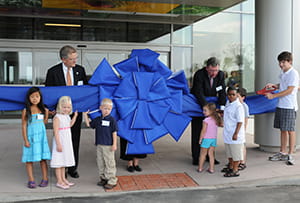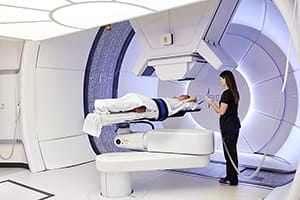Liberty Campus celebrates 10 years
On August 11, 2008, Liberty Campus opened for patient care for the first time. The three-story, 230,000 square-foot facility, located at the intersection of I-75 and State Route 129, was the largest off-site expansion in Cincinnati Children’s history. It boasted eight operating rooms, a pediatric emergency department and 12 short-stay observation beds, as well as subspecialty clinic space, faculty and administrative offices, imaging and lab services, and various therapies.
Jamie Theiss was director of operations for Liberty Campus in those early days (he is now senior director of operations for Liberty Campus and all neighborhood locations). “It was 2006, and I was stationed in a trailer in the middle of a cornfield,” he recalls. “There was little else out there, except for Lakota East High School and Kroger’s.”
Liberty Campus was built in response to the growing northern population and the dearth of healthcare services available there. “The population growth had actually started 20 years earlier, but development hadn’t kept up,” Theiss says.
Fast-forward to 2018. Liberty Township is now a healthcare hub. Mercy Health, Christ Hospital and Premier Health are among the adult systems that have built facilities in the area. Liberty Campus has grown too – into a four-story, 42-bed full-service hospital, complete with a $120 million Proton Therapy Center. The fourth floor opened in 2015, and the Proton Therapy Center came online in 2016.
An evolution
Patients, families and staff love the experience at Liberty Campus, citing the ease of parking and wayfinding, as well as the building design, with its expansive windows and bright colors.
“On average, we have about 700 employees here,” says Theiss. “That relative smallness drives cross-departmental relationships. In the cafe, you’ll see groups of people from all different divisions having lunch together. There are fewer silos.”
The type of patients coming to Liberty has also changed.
“The Cancer and Blood Diseases Institute has brought patients of much higher complexity to Liberty,” says Theiss. “Ten of our 42 beds are dedicated to their program.”
Additionally, the opening of a 10-bed Transitional Care Center on the fourth floor has raised the patient acuity and complexity.
The mix of surgical procedures performed at Liberty Campus has grown across all services to include the ability to treat some emergent patients with an on-call team. Previously, these patients were transported to Burnet Campus.
Says Theiss, “Initially, patients who came to Liberty Campus were predominantly local, but over time, we’ve seen a significant increase in patients coming from other areas. We attribute this to an expansion of service offerings, patients following their physician, and easier access.”
What’s next?
Liberty Campus has exceeded the expectations of those who first envisioned it. The ED/Urgent Care volumes have nearly doubled, and the Department of Surgery has experienced steady growth. The average daily inpatient census has increased seven-fold since the expansion. And the Proton Therapy Center is a national hub for particle-based cancer research.
“I predict that Liberty Campus will continue to be a strategic facility for providing access to high quality care in the region and building system capacity. It will be critical for our northern strategy,” says Theiss. “We’ve come a long way in 10 years. I’m excited to see what the next 10 will bring.”





